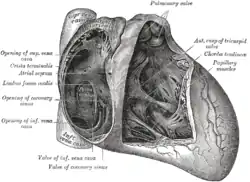Crista terminalis
The crista terminalis represents the junction between the sinus venosus and the heart in the developing embryo.[1] In the development of the human heart, the right horn and transverse portion of the sinus venosus ultimately become incorporated with and forms a part of the adult right atrium,[1] where it is known as the sinus venarum. The line of union between the right atrium and the right atrial appendage is present on the interior of the atrium in the form of a vertical crest, known as the crista terminalis or crista terminalis of His.[2] The crista terminalis is generally a smooth-surfaced, thick portion of heart muscle in a crescent shape at the opening into the right atrial appendage. On the external aspect of the right atrium, corresponding to the crista terminalis is a groove, the terminal sulcus. The crista terminalis provides the origin for the pectinate muscles.
| Crista terminalis | |
|---|---|
 Interior of the heart, frontal view (crista terminalis labeled on the left, second from the top) | |
| Details | |
| Identifiers | |
| Latin | Crista terminalis atrii dextri |
| TA98 | A12.1.01.003 |
| TA2 | 4025 |
| FMA | 9236 |
| Anatomical terminology | |
See also
References
This article incorporates text in the public domain from page 509 of the 20th edition of Gray's Anatomy (1918)
- Pieper, Matthew S.; Araoz, Philip A. (2016-01-01), Herrmann, Joerg (ed.), "Chapter 5 - Cardiac Tumors: Imaging", Clinical Cardio-Oncology, Elsevier, pp. 77–90, doi:10.1016/b978-0-323-44227-5.00005-3, ISBN 978-0-323-44227-5, retrieved 2020-11-17
- Sadler, T. (2010). Langman's medical embryology (11th ed.). Philadelphia: Lippincott William & Wilkins. p. 172. ISBN 978-0-7817-9069-7.
External links
- Anatomy photo:20:13-0106 at the SUNY Downstate Medical Center - "Heart: Chamber of Right Atrium"
- Atlas image: ht_rt_atrium at the University of Michigan Health System - "Right atrium, internal structure, anterior view"
- Diagram at ctsnet.org